The huts, of varying sizes and often enclosed by a fence, were generally almost rectangular in shape with one of the short apsidal sides, generally open on the long side, with two aisles and a gable roof. Inside each structure there was a hearth, but often a larger oven was also installed externally for production purposes. The settlement of Poggiomarino, in fact, since the most ancient phases of the Iron Age (IX – VIII century BC), was characterized by handicraft activities of metal, bone, glass paste and amber artifacts, taking shape therefore as an important center of production and exchange of prestige goods. Archaeometric analysis on amber allowed us to confirm that this raw material came from other places, beyond the Baltic. For the “Orientalizing period” (VII century BC), a local fusion activity of metals was also ascertained in Poggiomarino, and isotopic analysis (Isotopengéologie Laboratory of the University of Bern) on lead confirmed that this metal was imported both from South-western Sardinia and from southern Spain (Rio-Tinto Huelva and / or Alpujarride region).
Textile activity, of a domestic nature, must have been fundamental for the local community, as numerous loom weights were found for weaving.
The subsistence economy of this community was mainly based on agriculture and livestock, however, in Poggiomarino, hunting and fishing activities are also documented – irrelevant though, from an economic point of view.
Furthermore, we know that the ancient inhabitants of these marshes also collected spontaneous fruits such as hazelnuts, blackberries, carnelians and – as fodder for the breeding of animals – acorns and oak-galls. There was also a cultivation of cereals and legumes (broad beans), as well as the pressing of grapes to produce wine. Numerous grape seeds were found whose morphobiometric study (dr L. Costantini) confirmed their origin from fruits of cultivated vines.
Also the analysis carried out on the faunal remains (animal bones and malacofauna – which is mollusks) have provided very significant information. The bone remains attributed to domestic animals (cattle, sheep and goats and pigs, but also horses and dogs) are predominant compared to those attributed to wild species (deer and wild boar). Livestock breeding therefore played a primary role in the subsistence economy of Poggiomarino, as cattle, sheep and goats and pigs were the main source of meat to which must have been added, albeit modestly, that from wild mammals and birds. Pigs were only bred for meat production while other domestic animals also provided other resources: cattle had great importance in agricultural work and sheep and goats were exploited for wool, and large and small ruminants could supply skins, horns and bones to work, but also milk for dairy production. As for the horses, of rather limited number, it was thought that their meat did not fit into the eating habits of the local people, and they were used as mounts or draft and loading animals. Among the wild animals the deer is the most widely attested above all through the presence of antlers (the branched appendages of the cervids), some of which were worked. Among the birds, there were animals related to the fluvial-marsh environment such as ducks (geese and ducks) and waders. Otters and turtles are also attested in Poggiomarino – portions of carapace (turtle shell) and plastron (ventral bone plate of the turtle shell) were found. The collection of turtles was evidently for food purposes.
The archeomalacological investigations (studies of ancient mollusks through the observation of the shells) have identified the presence of fresh water, continental and marine mollusks. The first two species were probably collected around the site for food purposes while for marine species they apparently came from sandy bottoms of the ancient mouth of the Sarno river. The perforation of a large number of valves and the shaping of anthropogenic origin of some shells attest to their use for ornamental or ritual purposes. The remains of ichthyofauna (the fish life of this region) are scarce, but the discovery “in situ” (on site) of numerous bronze hooks and net weights confirm the activity.
A very interesting datum emerged from the analysis conducted on some samples of pebbles found in very large quantities in Lòngola: they came from Ischia and from Sardinia. The hypothesis has been advanced by G. Di Mais according to which this material would have been used as a ballast for boats that arrived empty at Poggiomarino and would then leave full of cereals from there – during the Iron Age the entire plain of Sarno had wheat and cereals growing on it – or even prestige goods.
The huge amount of wood recovered in the village of Lòngola, above all poles and boards for the reclamation and regimentation of the banks of the canals but also structural elements required xylological analysis (xylology = study of wood): the genus “Quercus” (oak tree) was the most represented , both for the excellent characteristics of resistance and, obviously, for the abundant availability in the areas surrounding the settlement. In Poggiomarino, this species had very wide and well-spaced growth rings, typical of trees grown in a damp plain forest, but there is no lack of oaks with more rings, coming from the nearby mountains. Very significant is also the use of boards made of white fir wood, with good durability, which came from areas quite far from the site; this shows an ability to select the material according to the specific need for use. (1)
NOTE:
Magna Graecia (Megalē Hellas) refers to the coastal areas of Southern Italy which were colonized by various ancient Greek city-states from the 8th to 5th centuries BC
BIBLIOGRAPHY:
1) Caterina Cicirelli, Stato delle ricerche a Longola di Poggiomarino: quadro insediamentale e problematiche, in Pietro Giovanni Guzzo e Maria Paola Guidobaldi, Nuove Ricerche archeologiche nell’area vesuviana (scavi 2003-2006), Atti del Convegno Internazionale, Roma 1-3 febbraio 2007, L’Erma di Bretschneider, 2008, pp. 476-480
For further info about our guided tours of Pompeii





Leave a Reply
Want to join the discussion?Feel free to contribute!